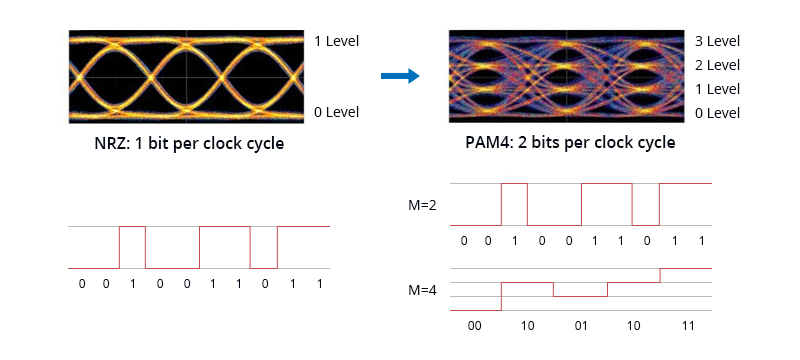PAM4 and Coherence Technology in 100G DWDM Optical Transceiver
PAM4 and Coherence Technology in 100G DWDM Optical transceiver
By using standard optical transceivers (such as CFP and QSFP28), 100G transfers within the data center are possible. Although they are well suited for transmitting 100G traffic within racks and data centers, this can become a problem when 100G traffic needs to be transmitted over long distances (for example, long connections between different data centers (for example, over 40km)). This requires a 100G DWDM optical transceiver.
Since DWDM SFP transceivers are widely used for scaling up 10G network capacity, DWDM technology is not new to the industry. In terms of functionality, the 100G DWDM is very similar to its predecessor. However, it is often used for longer distances in a 100 gigabyte network.
PAM4 and Coherence are two industry-leading solutions that offer greater bandwidth and transmission distance. When comparing 100G DWDM PAM4 to a coherent optical transceiver, it depends on what functions the network needs and benefits from. In this article, we will analyze both options to help businesses make informed decisions.
What is the PAM4 optical transceiver?
The Pulse Amplitude Modulation (or PAM4 optical device) was created to respond to the need for optical transceivers for short distance links. It uses four different pulse ranges to convey information. Each amplitude has two digits, which doubles the data rate and makes PAM4 twice as bandwidth efficient as the traditional binary model.

PAM4 Advantage
Prior to PAM4, the binary NRZ modulation format was used for 100G long distance and 40G data transmission networks. PAM4 comes with four different code types for encoding two bits of data, so the bandwidth of the connection can be doubled with this modulation format. Today, single-wavelength PAM4 modulation technology is being used because it is considered to be the most efficient and cost-effective driver of 100 gigabytes of data transmission.
PAM4 optical transceivers can be directly used in switches in embedded DWDM networks. This is a cost-effective and simple solution for customers willing to build embedded DWDM data networks.
PAM4 Disadvantage
One of its drawbacks is that the PAM4 optical transceiver requires an amplifier to transmit over 5km. In this case, a separate DWDM multiplexer equipped with dispersion compensation and an amplifier is required to connect the data center. In addition, if the PAM4 optical transceiver is used in conjunction with an existing DWDM network, the DCM and amplifier must be prepared first to avoid future problems.
Another drawback is that PAM4 is susceptible to noise. Its extra voltage level requires a reduced level interval, leading to a higher signal-to-noise ratio, which is why PAM4 works best in short-range optical systems.
Coherent optical transceiver
Coherent optical communication is a kind of optical transmission which uses local oscillator light for coherent detection. It uses DSP. It has the ability to reach or exceed a transmission rate of 100 gigabits, requiring only a pair of optical fibers to transmit terabits of data, usually for long-distance applications.
Coherent advantage
The main advantages of the coherent optical transceiver are the built-in DSP chip and electronic dispersion compensation (EDC), which is not available in PAM4. This chip does not need a separate DSP and dispersion compensation transceiver, but uses EDC to improve the power.
Coherent optical devices can be transmitted over distances of up to 1000km, enabling long-distance support without the need for third-party systems. Using techniques used in radio communications, coherent optics can improve receiver sensitivity while maintaining selective tuning, which allows the channel spacing to be close but still separate.
Coherent disadvantage
Although CFP and CFP2 digital coherent optics can work quickly and efficiently, they use more power and cost more when compared to other packages, and these disadvantages can impact total operating costs, posing challenges for companies that need high-quality 100G DWDM pluggable optical transceivers within their budget.
Another disadvantage of coherent optical transceivers is that two DSPs from the same vendor will be required at both ends of the link. Different DSPs cannot work together, and in some cases the line card must be the same.
Conclusion
To sum up, 100G PAM4 optical transceivers can be selected within 80km, 100G coherent optical transceivers can be selected beyond 80km, and any combination of optical transceivers can be used in data centers according to their specific requirements. The popular DWDM technology has been extended to 200G line speeds, helping to maintain the complexity and cost factor of data communication networks. DWDM will be the primary multiplexer for 100G systems compared to passive multiplexers that enable services under 10G for multi-channel CWDM/ DWDM networks.



